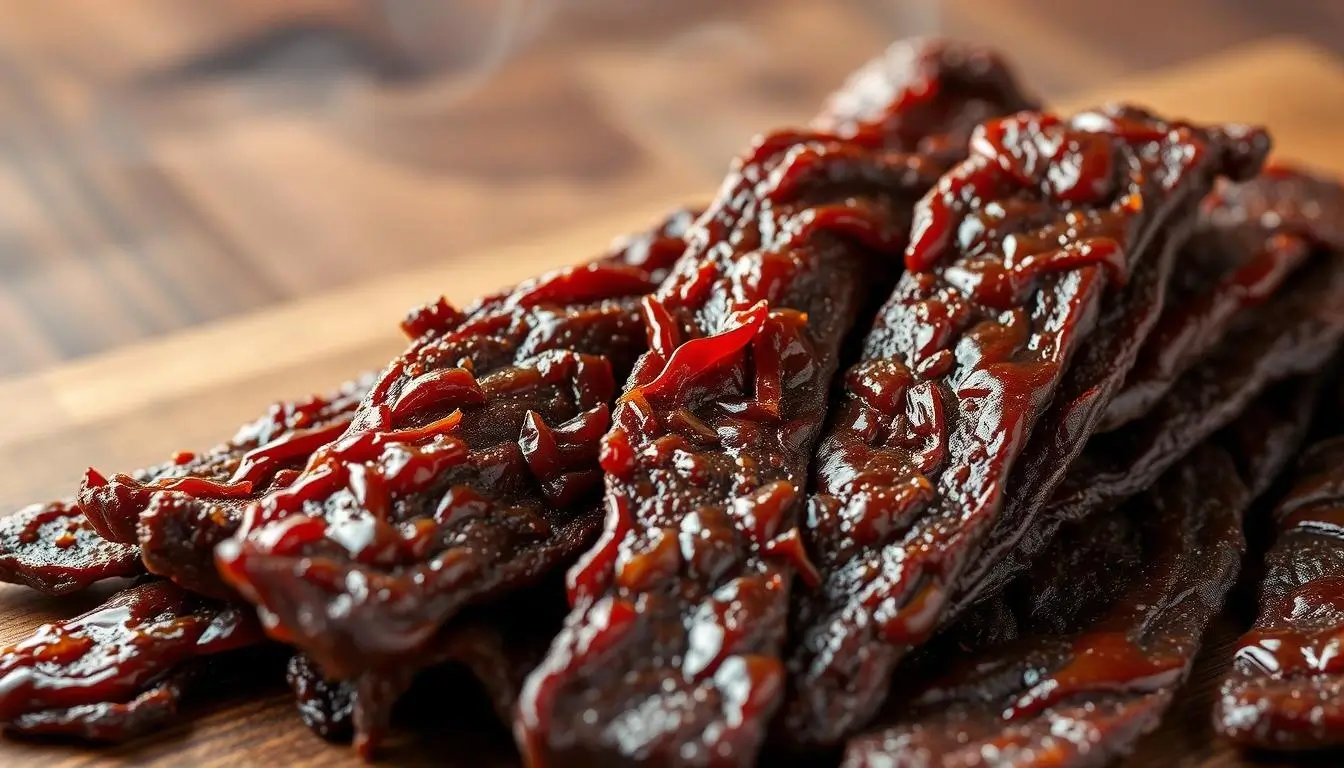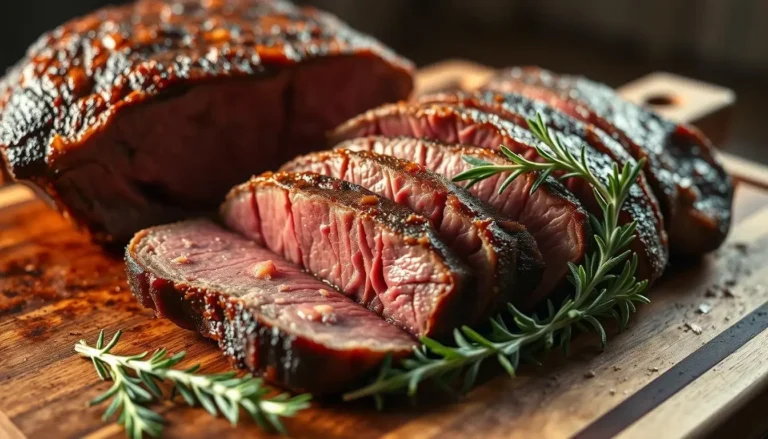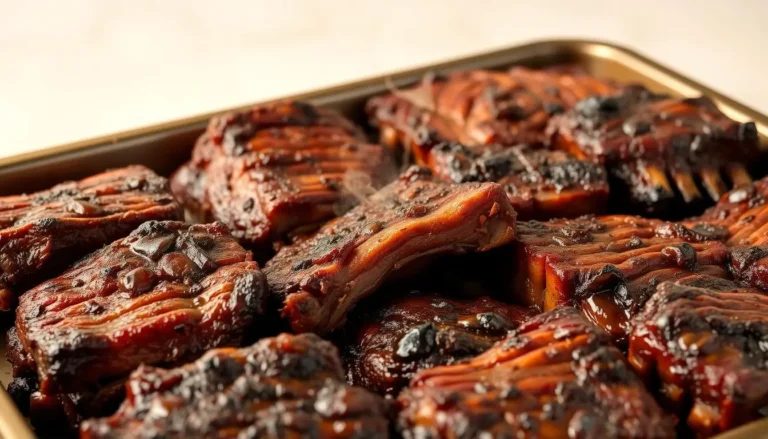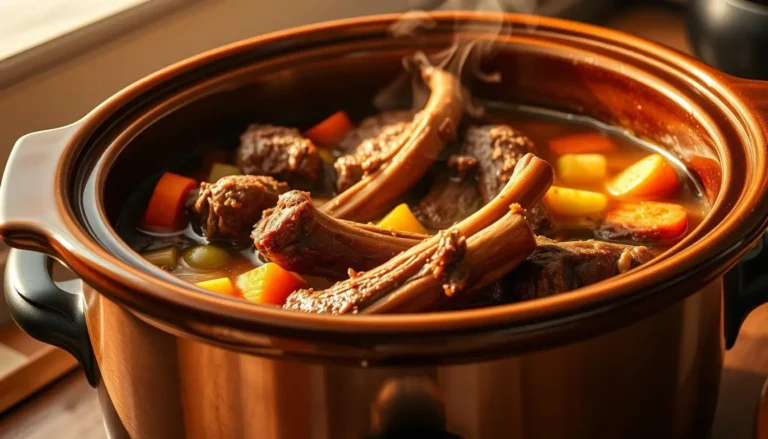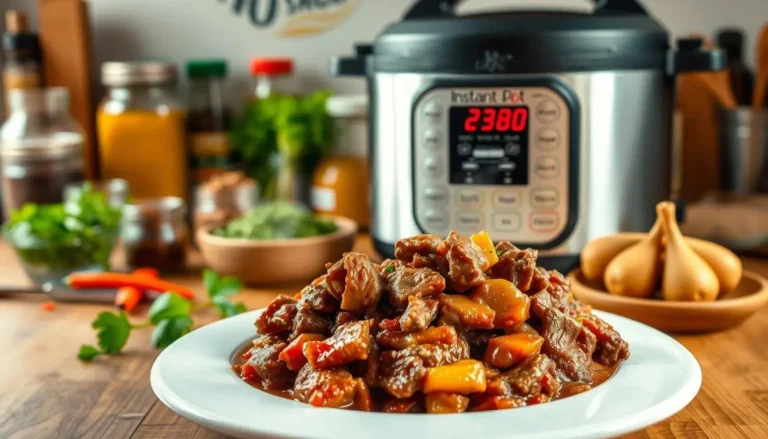How to make the perfect teriyaki jerky recipe at home.
Table of Contents
Teriyaki Jerky Recipe
Picture this: You’re on a road trip, craving a savory snack, but store-bought options taste overly sweet or suspiciously artificial. That’s exactly what happened to me last summer—until I decided to take matters into my own hands. After weeks of testing, I discovered that crafting homemade teriyaki-style jerky isn’t just rewarding—it’s a game-changer for flavor and quality.
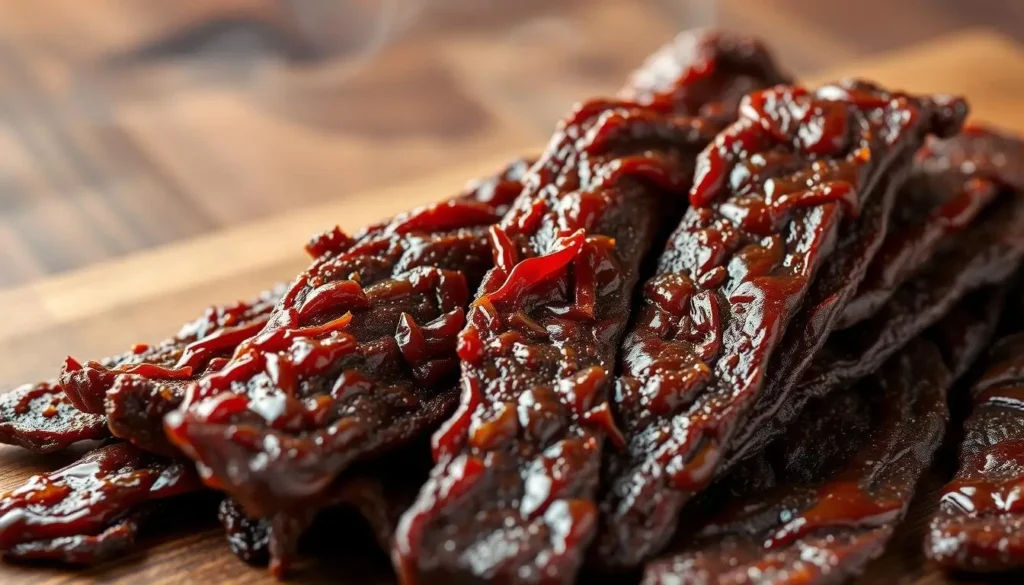
This guide isn’t about complicated steps or fancy tools. Instead, it’s about unlocking the secrets to tender, flavorful strips that you control from start to finish. Whether you’re a first-timer or a seasoned cook, you’ll learn how selecting the right cuts of beef, balancing your marinade, and mastering drying methods can elevate your results.
We’ll walk through everything: trimming excess fat for better texture, marinating for depth of flavor, and using equipment like a dehydrator or oven. You’ll even get tips on slicing meat thinly (hint: the freezer is your friend). By the end, you’ll have a stash of preservative-free snacks that outshine anything from a store shelf.
Key Takeaways
- Homemade versions let you adjust flavors and avoid unwanted additives.
- Choosing lean cuts ensures better texture and longer shelf life.
- Marinating time directly impacts the depth of savory-sweet taste.
- Dehydrators, ovens, or smokers offer flexibility for drying.
- Pre-freezing meat makes slicing uniform strips effortless.
- Effective storage methods ensure your jerky remains fresh for several weeks.
Why Homemade Teriyaki Jerky is a Cut Above Store-Bought
Ever wonder why your favorite snack tastes so different when you make it yourself? Store-bought options often rely on shortcuts—excessive sodium, vague “natural flavors,” and chewy textures. When you craft your own version, you gain full command over every savory detail.
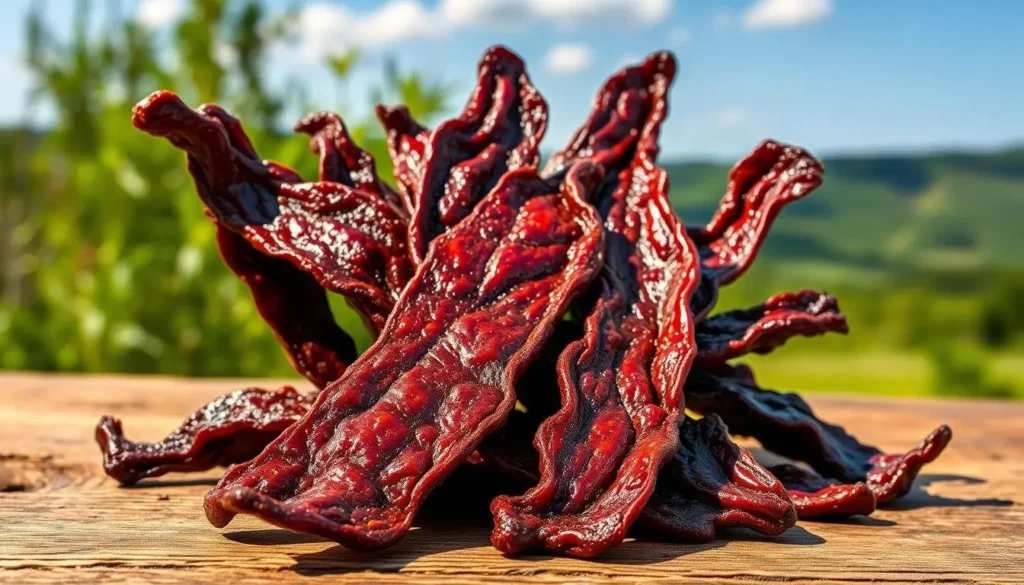
Benefits of Making Your Own Jerky
Many commercial jerky options contain around 500mg of sodium per ounce, accounting for nearly 25% of your recommended daily intake. By mixing your marinade, you slash salt while boosting depth with fresh garlic or ginger. You’ll also skip preservatives like sodium nitrite, which the CDC links to health risks when consumed regularly.
| Factor | Homemade | Store-Bought |
| Sodium per serving | 220mg | 500mg |
| Preservatives | 0 | 3-5 common additives |
| Texture | Customizable chew | Often rubbery |
| Flavor flexibility | Unlimited variations | Standardized taste |
Control Over Ingredients and Flavor
Your kitchen becomes a flavor lab. Swap generic soy sauce for a premium low-sodium version, or add pineapple juice for natural sweetness. A chef’s blog recently noted that marinating lean cuts for 12-24 hours creates richer umami layers than mass-produced alternatives.
Thinly sliced meat absorbs flavors faster, letting you adjust spices mid-process. One home cook reported doubling the black pepper in their blend for extra heat—something factories can’t replicate. Plus, you decide how smoky or sweet your final product becomes.
Choosing the Best Beef and Prepping Your Meat
The foundation of great homemade snacks starts long before the marinade. Your choice of beef and prep method determines whether you’ll get chewy leather or tender, flavorful strips. Let’s break down how to set yourself up for success from the very first step.
Selecting the Ideal Beef Cut
Lean cuts like eye of round or top round work best—their minimal fat content prevents spoilage and ensures even drying. Trimming visible sinew matters too. As one professional butcher notes, “Meat with less marbling dries faster and absorbs flavor more efficiently.”
Slicing Techniques for Tender, Even Strips
Partially freeze your meat for 30-45 minutes to firm it up. This trick lets you slice uniform ¼-inch pieces without tearing. Always slice against the grain to achieve optimal tenderness. If your knife slips, place a non-slip sheet under the cutting board.
Consistent thickness means every piece dries at the same rate. For extra precision, ask your butcher to pre-slice the cuts—many offer this service free. Remember: careful prep transforms good snacks into crave-worthy ones.
Building Your Signature Teriyaki Marinade
Crafting a memorable marinade requires balancing science and creativity. The right blend of liquids and spices transforms plain meat into crave-worthy strips bursting with complex flavors. Let’s dissect how each component works together to create harmony in every bite.
Wet Ingredients: Soy Sauce, Vinegar, and More
Start with 1 cup soy sauce as your salty-umami base. Incorporate ¼ cup of rice vinegar for a zesty kick and 2 tablespoons of toasted sesame oil to introduce a rich, nutty flavor. Dark brown sugar (⅓ cup) caramelizes during drying, creating a glossy finish. Fresh grated ginger (1 tablespoon) and minced garlic (3 cloves) add aromatic warmth.
| Ingredient | Purpose | Impact |
| Soy Sauce | Salt foundation | Enhances meat proteins |
| Rice Vinegar | Acidity balance | Tenderizes fibers |
| Sesame Oil | Fat carrier | Releases spice flavors |
| Brown Sugar | Caramelization | Creates chewy texture |
Dry Spices and Flavor Enhancers
Combine 1 teaspoon black pepper with 2 tablespoons sesame seeds for crunch. Garlic powder (½ tsp) boosts savory notes, while red pepper flakes (optional) add heat. For extended freshness, mix in ¼ teaspoon curing salt—this inhibits bacterial growth without altering taste.
Marinate slices in a container for 8-24 hours. Longer soaking allows flavors to penetrate deeper. Stir halfway to ensure even coverage. Heat the blend for 5 minutes prior to combine components at ambient temperature. Your next step? Letting science work its magic before drying.
Mastering the teriyaki jerky recipe
Perfecting your savory strips requires precision in two areas: timing and taste. While the process isn’t complex, small missteps can lead to uneven flavor or texture. Let’s explore how to balance these elements for consistent results.
Marination Time and Temperature Guidelines
Marinate your beef for 8-24 hours in the refrigerator (34-40°F). This range prevents bacterial growth while letting flavors penetrate deeply. Thin slices absorb marinade faster—check thicker cuts at the 12-hour mark.
During drying, maintain these temperatures:
- Smoker: 160-180°F for 4-6 hours
- Oven: 170°F for 3-5 hours
Use a meat thermometer to verify doneness. Properly dried strips bend without breaking and lack visible moisture.
Adjusting Seasonings to Taste
SStart with 1 tsp salt per pound of meat, then tweak. Reduce sodium by 25% if using soy sauce, or add smoked paprika for earthiness. For heat, mix in chili powder gradually—½ tsp increments prevent overpowering.
Test batches in 1-pound portions:
- Marinate 8 hours with base flavors
- Add extra spices (garlic, pepper) to half the batch
- Compare results after drying
This method helps refine your ideal blend without wasting ingredients. Remember: temperature control preserves flavor integrity during both marinating and drying phases.
Cooking Methods: Smoker, Oven, and Dehydrator Options
Which drying technique preserves flavor best while achieving ideal texture? Your equipment choice shapes both taste and mouthfeel. Let’s examine how smokers, ovens, and dehydrators transform marinated strips into portable protein.
Heat Source and Flavor Outcomes
Smokers infuse meat with woody aromas using 160-180°F heat over 4-6 hours. This method pairs well with bold marinades—the smoke doesn’t overpower soy or garlic notes. However, thicker cuts may dry unevenly without frequent rotation.
Ovens offer convenience. Set to 170°F and prop the door open with a wooden spoon. This airflow prevents steaming, mimicking dehydrator conditions. Expect milder flavors compared to smoked versions, but perfect for those preferring tangy-sweet profiles.
| Method | Temperature | Time | Flavor Impact | Best For |
| Smoker | 160-180°F | 4-6 hours | Robust smokiness | Outdoor enthusiasts |
| Oven | 170°F | 3-5 hours | Subtle sweetness | Quick batches |
| Dehydrator | 155-165°F | 5-7 hours | Concentrated marinade | Precision drying |
Equipment-Specific Success Tips
Dehydrators excel at consistency. Arrange slices in single layers without overlapping. Use 155°F for chewy results or 165°F for crispier bites. Every 90 minutes, if your model has uneven airflow, make sure to rotate the trays.
For fatty cuts, blot excess oil with paper towels mid-drying. Store finished strips in airtight bags with silica packets to absorb residual moisture. If flavors fade during cooking, lightly brush slices with diluted teriyaki sauce in the final 30 minutes.
Storage, Serving Suggestions, and Nutritional Insights
Your homemade creation deserves to stay fresh and flavorful long after drying. With smart storage and creative pairing, you’ll maximize both shelf life and enjoyment.
Proper Storage Techniques for Longevity
Keep strips in airtight bags or vacuum-sealed containers. Uncured versions last 2-3 weeks in the fridge, while cured batches stay safe at room temperature for up to a month. For freezer storage, wrap portions in wax paper first to prevent clumping.
- Incorporate silica gel packets to eliminate any remaining moisture
- Label bags with dates to track freshness
- Avoid plastic containers that trap condensation
Serving Ideas and Nutritional Information
Pair smoky strips with sharp cheddar or crumble them over salads for added protein. One ounce packs 9g protein and 70 calories—ideal for on-the-go fuel. Measure seasonings with a teaspoon or tablespoon to maintain consistency across batches.
| Serving Style | Pairing | Calories per Serving |
| Snack Pack | Almonds + Dried Fruit | 150 |
| Salad Topper | Mixed Greens + Vinaigrette | 220 |
| Trail Mix | Dark Chocolate + Pretzels | 180 |
For larger batches, a dehydrator ensures even drying, which extends shelf life. Refrigerate opened packages immediately to preserve texture and taste.
Conclusion
Transform your kitchen into a flavor workshop where you craft protein-packed snacks tailored to your taste. By selecting lean beef, mastering precise marinade ratios, and controlling drying temperatures, you’ve learned to create strips that outperform store versions in both quality and nutrition.
Homemade batches slash sodium by 50% compared to commercial options while letting you tweak spices like garlic or chili powder. Whether using an oven, dehydrator, or smoker, maintaining 160-180°F for 4-6 hours ensures safe, even results. Marinate for 8-24 hours to let soy and ginger penetrate every fiber.
Store your creations in airtight bags with silica packets for up to a month. Share smoky strips on hiking trips or crumble them into salads for bold flavor boosts. Experiment with pineapple juice for sweetness or smoked paprika for depth—your pantry is the limit.
Ready to become a beef jerky maestro? Grab your knife, fire up the dehydrator, and tag us in your creations. Your next savory adventure starts now.
FAQ
How long should you marinate the meat for optimal flavor?
Marinate sliced beef in the refrigerator for 6–12 hours. This allows the soy-based mixture to penetrate deeply, creating a balanced sweet-savory profile without overpowering the meat.
Can you use a dehydrator instead of an oven?
Yes. Set your dehydrator to 160°F (71°C) and dry the strips for 4–6 hours. Check periodically for desired texture—flexible but not brittle—to avoid over-drying.
What cuts work best for tender results?
Lean cuts like top round or flank steak are ideal. Trim visible fat before slicing to prevent spoilage and ensure even drying. Cut against the grain for a softer bite.
How do you store homemade jerky to keep it fresh?
Place cooled strips in an airtight container or resealable bag. Store in a cool, dry pantry for up to 2 weeks, or refrigerate for 1–2 months. For longer storage, freeze for 6+ months.
Is brown sugar necessary for the marinade?
Brown sugar adds caramelized depth, but honey or maple syrup can substitute. Adjust sweetness to taste, balancing the salty tang of soy sauce and acidity from rice vinegar.
Can you add heat to the seasoning blend?
Absolutely. Incorporate red pepper flakes, chili powder, or a dash of sriracha to the marinade. Start with small amounts and taste-test before committing to larger batches.
Why is apple cider vinegar used in some recipes?
Its mild acidity tenderizes the meat and brightens the marinade’s richness. Substitute with pineapple juice for a tropical twist or rice vinegar for a subtler tang.

